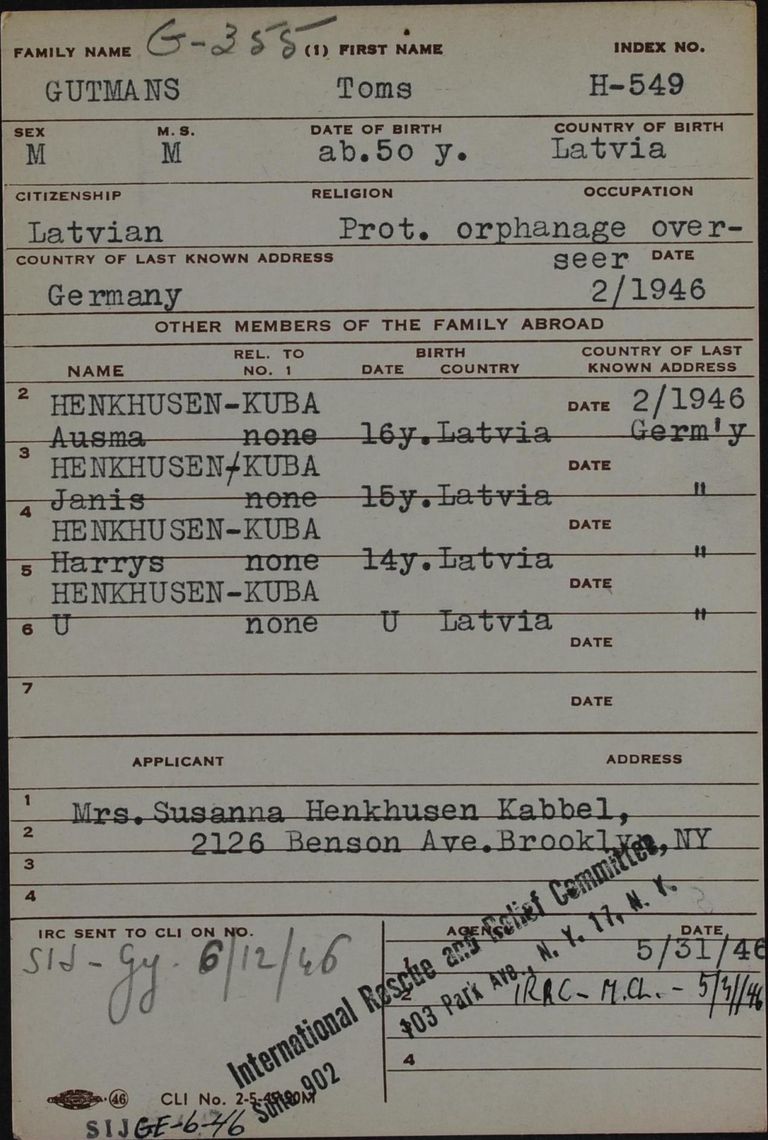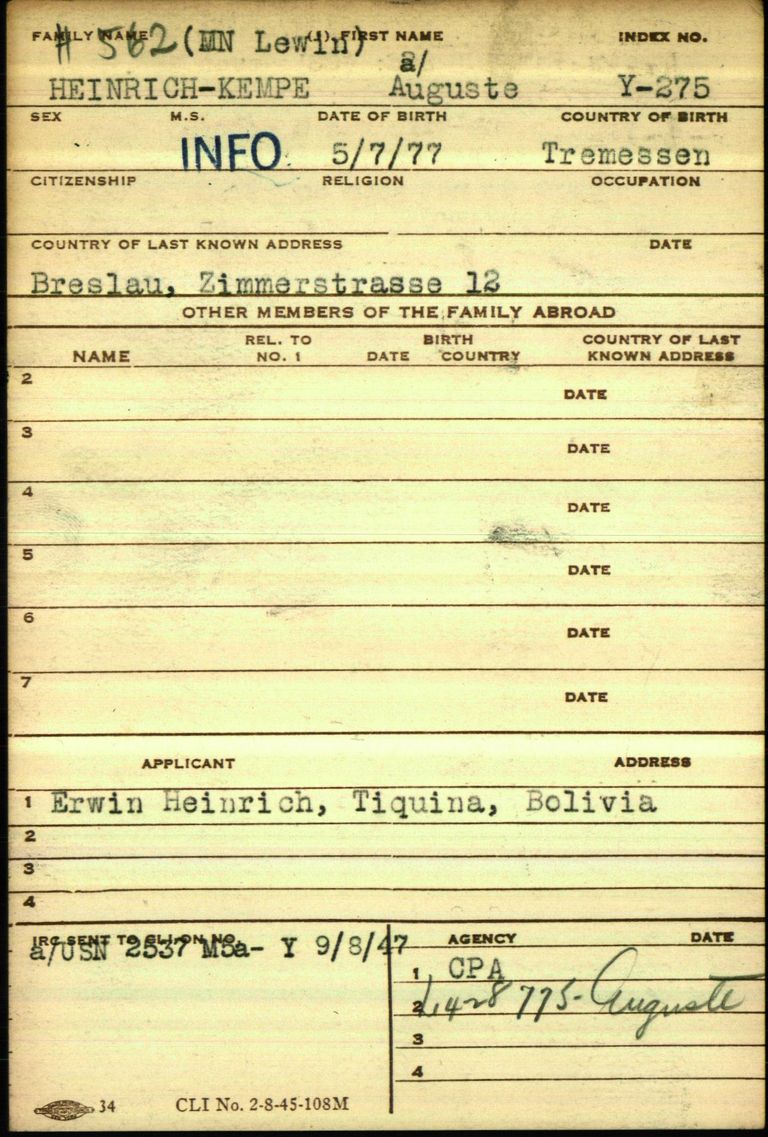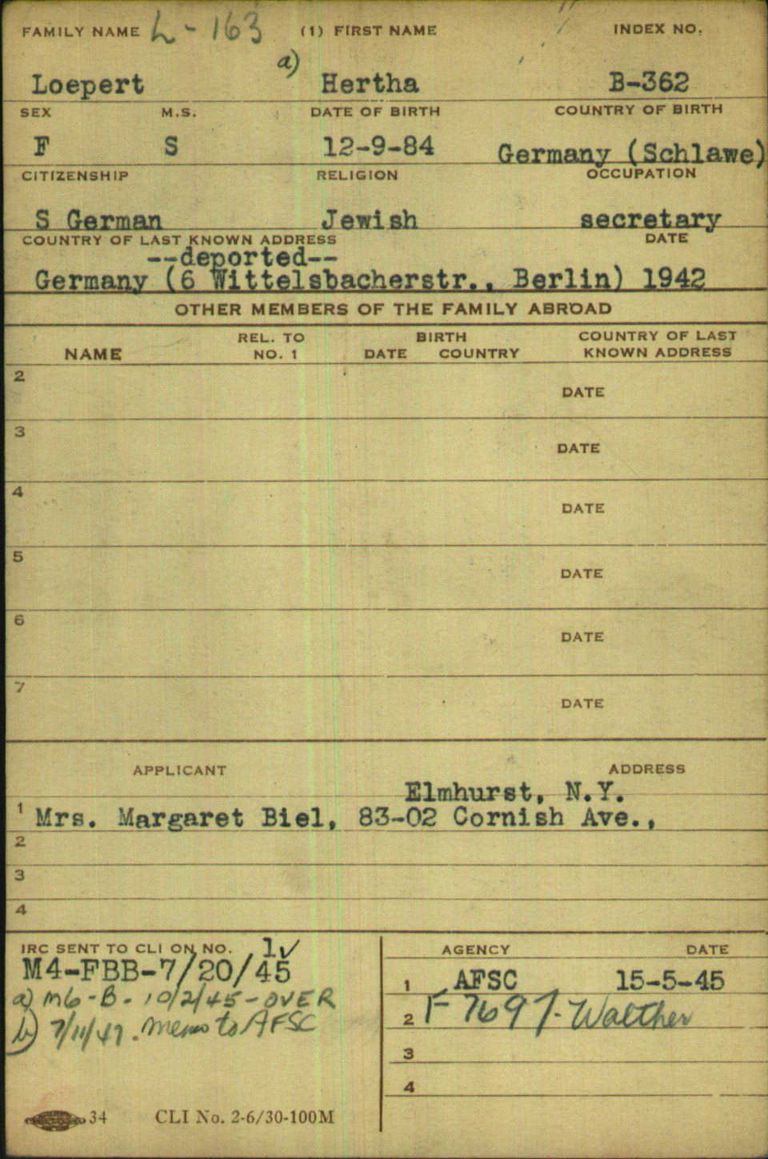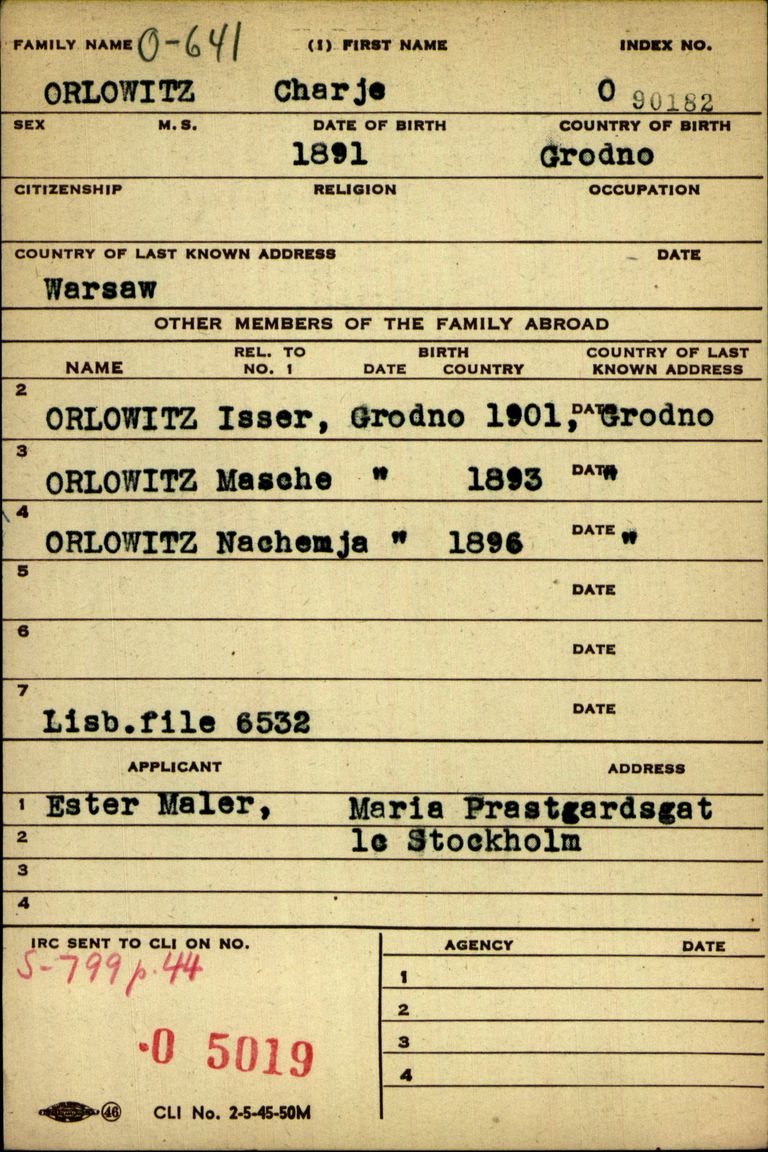Page of
Page/
- Reference
- Intro
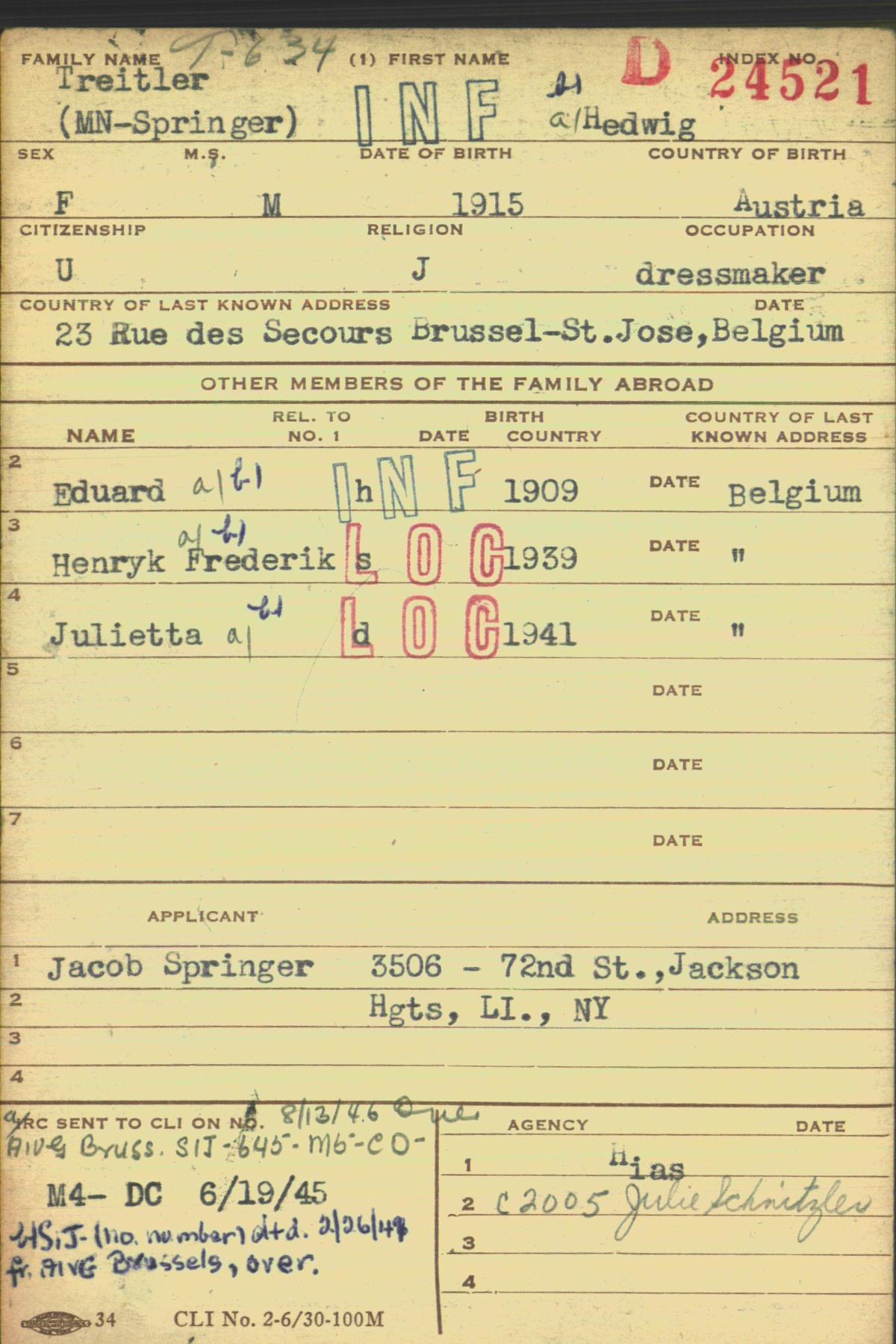

The Central Location Index (CLI) in New York was a central coordination office that registered search requests from American citizens for missing relatives overseas and facilitated the exchange of information between aid organizations in the USA and the organizations of the United Nations Relief and Rehabilitation Administration (UNRRA), the International Red Cross (IRC) and other public institutions in the liberated parts of Europe.
The CLI staff recorded the personal data of both searched for persons and persons registered as DPs in Europe in a central card file and documented the results of investigations and sources of information.
The Central Location Index (CLI) in New York was a central coordination office that registered search requests from American citizens for missing relatives overseas and facilitated the exchange of information between aid organizations in the USA and the organizations of the United Nations Relief and Rehabilitation Administration (UNRRA), the International Red Cross (IRC) and other public institutions in the liberated parts of Europe.
The CLI staff recorded the personal data of both searched for persons and persons registered as DPs in Europe in a central card file and documented the results of investigations and sources of information.
Questions and answers
-
Where was the document used and who created it?
Under the initiative of the American Jewish Joint Distribution Committee (JDC), seven American aid organizations set up the Central Location Index (CLI) in August 1944 as a coordinating body for the search for missing persons in Europe. The CLI, which was subsequently joined by other organizations, was governed by a council of representatives from the seven founding organizations. Moses A. Leavitt, Secretary of the JDC from 1940-46 and Vice-Chairman from 1947-65, acted as the CLI President. The work of the CLI was decisively shaped by its managing director Etta Deutsch. After her departure in November 1948, Carolin Flexner took over the management. At times, the CLI employed up to 75 people at its headquarters in New York.
The core element of the CLI was a central card file in which the search requests received by the member organizations and the names of surviving DPs were brought together and compared with each other.
- When was the document used?
After the CLI was established in August 1944, work began on setting up the card file. In autumn 1948, the CLI Board decided to wind up the organization until April/May 1949. In the meantime, the CLI was no longer required to register and process new search requests. The member organizations were instructed to submit new search requests directly to the ITS rather than to the CLI. Until its actual dissolution in May 1949, the CLI, with a reduced staff, was now only concerned with processing its old cases. Efforts on the part of the CLI to hand over its documents, including the card index, to the ITS for further use failed, as did the alternative plan to hand them over to the Jewish Agency for Israel (Sochnut). The JDC in New York finally took possession of the material. In 1957, the material was handed over to the archives of the Yad Vashem Holocaust Memorial in Jerusalem.
- What was the document used for?
As a result of the war, many people in the USA, Canada and Latin America lost contact with relatives and friends in Europe. In the hope of obtaining information about the whereabouts of relatives, thousands of them turned to Jewish and non-Jewish aid organizations with search requests even before the end of the war in order to obtain information about the whereabouts of their relatives via their information channels in neutral or liberated parts of Europe. The looming end of the war and the expectation that the number of search requests would explode when the war ended led to the founding of the CLI in 1944.
The idea behind the CLI was to pool the resources and information channels of the individual member organizations in a central coordination office and make them mutually usable. The aim was to avoid duplicate processing of different inquiries about the same people and to make use of any overlaps. To this end, the CLI maintained a central file.
Employees of the member organizations transferred the personal details and information from the search requests they received onto special index card forms and sent the completed cards to the CLI in New York. Once there, the cards were coded according to an alphabetical-phonetic system (Soundex) and sorted into the central card file.
Meanwhile, the CLI staff used the same index card forms to record the names of people who had been registered as DPs by cooperating organizations in the liberated parts of Europe and recorded in lists. After receiving such lists, the names of the DPs were compared with the data already available in the Central Index. If no search request had yet been made for a person, the CLI created a so-called L Card (L for "list") for them, whose index number was preceded by an L. The L Cards were coded and sorted into the central file in the same way as the Agency Cards created on the basis of search queries.
In around 40,000 cases, the CLI was able to secure information on the whereabouts of wanted persons and forward it to their relatives in America.
- How common is the document?
Between August 1944 and July 1948, the CLI registered and filed tracing requests for over 500,000 missing persons. In addition, the CLI registered almost 700,000 DPs via the list material sent to it from Europe, although not for all of them index cards were created. The CLI estimated that the card file contained a total of around 1.2 million cards.
The online archive of the Arolsen Archives contains over 1.3 million scans of cards from the CLI card index (Collection 7.11.1), which were created by employees of the Yad Vashem Holocaust Memorial and made available to the Arolsen Archives in 2021.
- What should be considered when working with the document?
In addition to the two main card types (Master Card, MC for short), the Agency and L Cards, the CLI's card index also contained so-called Cross Reference Cards (XR). These blue or green cards were created by CLI employees for people who were listed as family members on Master Cards. This made it possible to search for each person individually in the card index. The index numbers of the XR Cards corresponded to those of the associated Master Cards, so that the cross-reference to the main case was ensured.
If a Master or XR Card was temporarily removed from the card file for investigation purposes, the CLI staff issued a red placeholder card, a so-called Dummy, and inserted it into the card file in place of the removed card. The code and index number of the removed card as well as the name and date of birth of the person concerned were noted on it.
The blue INF and red LOC stamps, which can be found on many CLI cards, were probably used to mark completed searches. While the INF stamp was probably used to mark records of persons for whom information about their deportation or death was available, the LOC stamp probably indicated that the whereabouts of a wanted person could be established beyond doubt.
A detailed manual on the structure and functioning of the CLI card index can be found in the online archive of the Yad Vashem Holocaust Memorial.
If you have any additional information on these cards, we would be pleased to receive information at eguide@arolsen-archives.org. New findings can be incorporated into the e-Guide at any time and thus made available to everyone.
Help for documents
About the scan of this document <br> Markings on scan <br> Questions and answers about the document <br> More sample cards <br> Variants of the document
